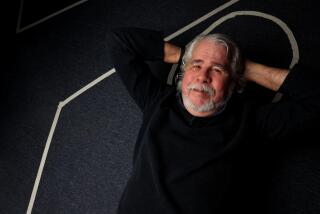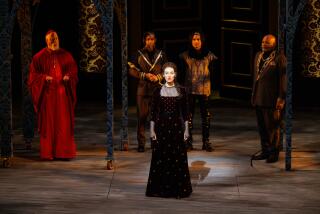CURTAIN RISES ON A LONG, HECTIC DAY
SAN DIEGO — Theatergoers mostly see only the end result of an artistic director’s labors--the plays on stage. What does a theater’s chief artistic visionary really do to earn his keep?
Flamboyant, stylish, energetic, witty and articulate bordering on glib, Jack O’Brien plays many roles as the Old Globe Theatre’s artistic director. Besides planning seasons and choosing many of the theater’s actors, directors and designers, he is collaborator, coach, mentor and at times father figure to the scores of creative people who work at the Globe. To lift the curtain for a peek behind the scenes, O’Brien was accompanied by a reporter on a recent work day.
The day is Wednesday, July 23. It is the height of the Old Globe’s season; more than 200 people are on the payroll. Six of seven summer festival shows are up and running on four stages (“Pump Boys and Dinettes” is playing at the San Diego State Mainstage Theatre).
This Wednesday is just two days before the world premiere of Steven Metcalfe’s “Emily,” a play about a young woman trying to decide if she has the courage to love. The day provides a chance to catch O’Brien in several roles.
Conferences. Time, 11:05. Place. O’Brien’s office. O’Brien hits the Globe administrative offices in Balboa Park and is inundated with greetings, hugs and a wave of briefings caught on the fly.
Globe Managing Director Tom Hall steps in from his adjoining office and updates O’Brien on the progress of a possible Globe collaboration with a well-known Broadway creative team as executive assistant Lynn Marvis hands O’Brien a handful of phone messages. Most are from New York or Houston, where O’Brien will restage his 1976 Houston Grand Opera production of “Porgy and Bess” for a national tour.
O’Brien and Hall discuss the pros and cons of working with the New York team.
O’Brien will direct Arthur Miller’s “All My Sons” for a fall “American Playhouse” air date, and calls are pending. O’Brien gives Marvis his New York schedule and asks her to tell “All My Sons” producer Michael Grandman and Lindsay Law, American Playhouse executive producer, to arrange a meeting with Arthur Miller. Daytime is preferable--”we should see theater in the evening,” O’Brien says.
Then there are plans for an August trip to Glyndebourne Theater Festival in England. The Brits have staged “Porgy,” and John DeMain, conductor of O’Brien’s “Porgy,” wants him to see the production.
Audition. Time, 11:40. Place, Rehearsal Hall A. An actress is being auditioned. O’Brien, Globe Executive Producer Craig Noel, and associate directors David Hay and Robert Berlinger troop through the building to the cavernous hall where the actress waits. O’Brien breaks the actress’s tension with a joke about the press.
She performs a scene as Queen Margaret from “Henry VI,” (Part 3, Act I), a scene from “Stage Door” and sings a song. The audition goes well. “That was the most won-derful audition. Very good. Very good,” O’Brien says. They thank her, then head back to the office. The associate directors have made written notes.
Lunch. 12 to 1. O’Brien doesn’t want the press along for lunch. He needs the hour to talk with an actor who has a problem.
Director’s notes. Time, 1:06 p.m. Place. Rehearsal Hall A. The 13 “Emily” cast members are seated in a circle on chairs.
O’Brien has a reputation as an actors’ actor, a director who understands actors, who has a way of building an ensemble, of making everyone in the cast feel important.
After some preliminary jokes, O’Brien gets down to business with, “In the immortal words of my deceased grandmother, ‘bleep it.’ ”
One of several notes for Madolyn Smith, who has the title role:
“Madolyn, you’ve got real pay dirt in ‘there aren’t enough . . . men to go around.’ Really lay it out for them. It’s amazing what’s going on in this. Just be aware that it is vindication for a lot of what goes on. It’s as if suddenly you get a power rush of ‘Right on, honey’ (from the audience).”
“How can I do it more?” Smith asks.
“Just lay it out for me. Just more authority, just meet those boys right there in the volleyball court and bat it right back at ‘em. Just have a good time, that’s all. It’s nothing intentionally you’re not doing. Just enjoy it.”
O’Brien gives actor Larry Drake a note on his scene as Emily’s drunk co-worker who starts coming on to her:
“Larry, I think what I’m asking for there that I haven’t gotten is that as you begin to go into your litany to her, you should accelerate, so that each thing batted away, goes forward, batted away, goes forward, so that actually it builds in rhythm toward the end: So OK, don’t sleep with me, marry me. Well, then such and such . . . . (The scene) tends to be pulling apart and going down as opposed to him whipping his little sled of huskies through this blizzard in front of him.”
Run-throughs. Time, 2:15. Place, the Old Globe Theatre. O’Brien takes the cast and technical crew through two hours of repetitious scene rehearsals in which problems from the previous night are corrected and rewrites are inserted. Scenes are repeated again and again.
O’Brien doesn’t like the curtain call and restages it, peps it up so that bows are made quickly to the beat of Bob James’ recorded score.
O’Brien ends the rehearsal at 4:20.
Administrative tasks. Time, 4:22. Place, O’Brien’s office. For 20 minutes O’Brien returns calls to New York and Houston. Associate Director David Hay comes in to say he has three concerns about Tuesday’s preview performance of “Emily.” O’Brien tells him two of the problems were resolved in rehearsal and takes the other under advisement.
By 5:30 O’Brien is chafing to get away. He, Hall and a reporter leave for dinner.
Precurtain director’s visits. Time, 7:45, 15 minutes before curtain for the third preview of “Emily.” Place, the labyrinth of dressing rooms beneath the Globe’s stage. O’Brien makes the rounds speaking to those he passes in the hall. He looks in on his leading actors. “One of the things an artistic director has to do is coerce people to do things outside the normal thing. I pace myself throughout the week, so that I don’t ask too many favors of people too quickly.”
He says Madolyn Smith, Brian Bedford (playing the title role in “Richard II” and directing “Much Ado About Nothing”) and Paxton Whitehead (playing the male leading role in “Much Ado,” and directing “Beyond the Fringe”) have agreed to take part in O’Brien’s “extracurricular” membership programs put on for major contributors to the Globe.
Intermission conference. Time, 9:15. Place, O’Brien’s office. O’Brien, Metcalfe and Hall huddle hastily in O’Brien’s office. None of them like the way the show is going.
“There is a mean atmosphere in that theater that I haven’t heard before,” Metcalfe says.
“Well, we’ve got a klatch here tonight,” Hall says.
Indeed, two groups on either side, at the rear of the auditorium, have raucously yucked it up at every funny line throughout the first half of the play.
“I don’t know,” O’Brien says. “Whoever they are, they came hearing that the show was hot and funny, and so they’re going to show us how much they know. This happens.”
“I think these people are intimidating the rest of the audience,” Metcalfe says.
O’Brien agrees that they are being alienated: “And the harder they work to get them back, the tougher the evening comes.”
“God I wouldn’t want to be on that stage tonight,” Hall says.
“I wouldn’t want to be backstage right now,” O’Brien adds.
Technical notes. Time, 10:30. Place, the Globe Theatre. O’Brien gives the stage manager, sound designer and technicians notes.
“Um, I want to try tomorrow without the first kiss cue,” O’Brien says. “It’s too cute. I think we should . . . let the lady act it. We’re helping too much, and it gets what I call hard-edged, don’t you think so?”
Heads nod. “General applause from my support team. I’m slow but I’m steady.”
Twenty minutes later, after calling a five-hour rehearsal for Thursday, O’Brien is ready to leave the theater.
Late night script revisions. Time, 11. Place, the Book and Candle restaurant downtown. O’Brien, Hall and Metcalfe adjourn for beer and more script changes. It is 11:15, more than 12 hours since the Globe’s artistic chief stepped into his office.
The reporter, who has been dogging O’Brien since 9:30 a.m., has had enough for one day, even if the Globe’s artistic visionary is still going strong.
More to Read
The biggest entertainment stories
Get our big stories about Hollywood, film, television, music, arts, culture and more right in your inbox as soon as they publish.
You may occasionally receive promotional content from the Los Angeles Times.










